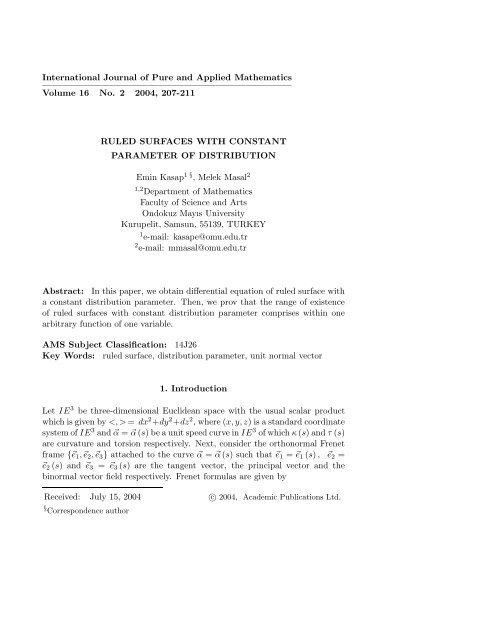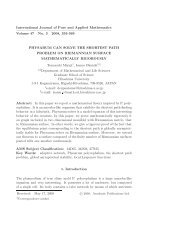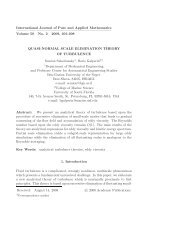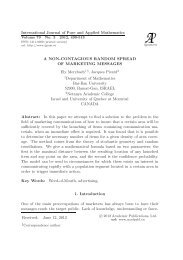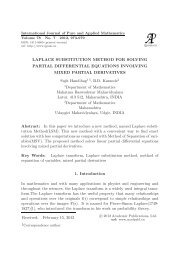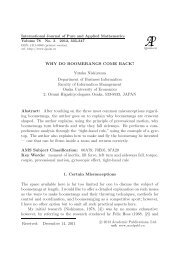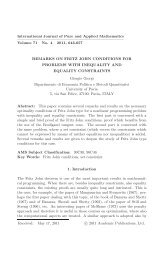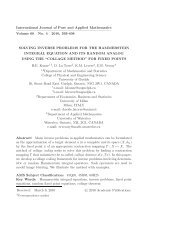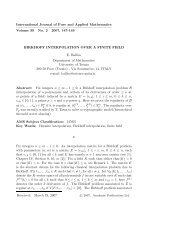RULED SURFACES WITH CONSTANT PARAMETER OF ...
RULED SURFACES WITH CONSTANT PARAMETER OF ...
RULED SURFACES WITH CONSTANT PARAMETER OF ...
You also want an ePaper? Increase the reach of your titles
YUMPU automatically turns print PDFs into web optimized ePapers that Google loves.
International Journal of Pure and Applied Mathematics<br />
————————————————————————–<br />
Volume 16 No. 2 2004, 207-211<br />
<strong>RULED</strong> <strong>SURFACES</strong> <strong>WITH</strong> <strong>CONSTANT</strong><br />
<strong>PARAMETER</strong> <strong>OF</strong> DISTRIBUTION<br />
Emin Kasap 1 § , Melek Masal 2<br />
1,2 Department of Mathematics<br />
Faculty of Science and Arts<br />
Ondokuz Mayıs University<br />
Kurupelit, Samsun, 55139, TURKEY<br />
1 e-mail: kasape@omu.edu.tr<br />
2 e-mail: mmasal@omu.edu.tr<br />
Abstract: In this paper, we obtain differential equation of ruled surface with<br />
a constant distribution parameter. Then, we prov that the range of existence<br />
of ruled surfaces with constant distribution parameter comprises within one<br />
arbitrary function of one variable.<br />
AMS Subject Classification: 14J26<br />
Key Words: ruled surface, distribution parameter, unit normal vector<br />
1. Introduction<br />
Let IE 3 be three-dimensional Euclidean space with the usual scalar product<br />
which is given by = dx 2 +dy 2 +dz 2 , where (x,y,z) is a standard coordinate<br />
system of IE 3 and α = α (s) be a unit speed curve in IE 3 of which κ(s) and τ (s)<br />
are curvature and torsion respectively. Next, consider the orthonormal Frenet<br />
frame {e1,e2,e3} attached to the curve α = α(s) such that e1 = e1 (s), e2 =<br />
e2 (s) and e3 = e3 (s) are the tangent vector, the principal vector and the<br />
binormal vector field respectively. Frenet formulas are given by<br />
Received: July 15, 2004 c○ 2004, Academic Publications Ltd.<br />
§ Correspondence author
208 E. Kasap, M. Masal<br />
e ′ 1(s) = κ(s)e2(s),<br />
e ′ 2(s) = −κ(s)e1(s) + τ(s)e3(s),<br />
e ′ 3(s) = −τ(s)e2(s),<br />
Furthermore, the e1,e2 and e3 vectors have a relations:<br />
(1.1)<br />
e1 ∧ e2 = e3, e2 ∧ e3 = e1, e3 ∧ e1 = e2. (1.2)<br />
Now, we define a ruled surface M in a three-dimensional Euclidean spaceIE3 :<br />
Ruled surfaces were investigated first by G. Monge who established the partial<br />
differential equation satisfied by all ruled surfaces (it is the third order). Thus,<br />
ruled surfaces were formed by a one-parameter set of lines and investigated by<br />
Hlavaty [5] and Hoschek [6]. The concepts of the striction point, the striction<br />
curve and the distribution (Chasles) parameter for ruled surfaces were earned to<br />
the differential geometry by M. Chasles [1]. The differential geometry of a ruled<br />
surface is developed based upon vector calculus as shown in many textbooks<br />
such as [2, 3, 7, 8, and 9].<br />
A straight line X in IE3 such that it is strictly connected to Frenet frame<br />
of the curve α = α(s) is represented, uniquely with respect to this frame, in<br />
the form<br />
3<br />
X(s) = xi(s)ei(s),<br />
i=1<br />
where the components xi = xi (s) (i = 1,2,3) are scalar functions of the arc<br />
length parameters of the curve α = α(s). Hence, as X moves along α = α(s) it<br />
generates a ruled surface given by the regular parameterization<br />
ϕ(s,v) = α(s) + v X(s),<br />
x 2 1 + x 2 2 + x 2 3 = 1, X ′ (s) = 0.<br />
(1.3)<br />
This ruled surface will be denoted byM. The curve α = α(s) is called a base<br />
curve and the various positions of the generating line X are called the rulings<br />
of the surface M. If consecutive rulings of a ruled surface in IE 3 intersect, then<br />
the surface is said to be developable. All other ruled surfaces are called skew<br />
surfaces. If there exists a common perpendicular to two constructive rulings<br />
in the skew surface, then the foot of the common perpendicular on the main<br />
ruling is called a striction point. The set of striction points on a ruled surface<br />
defines the striction curve.
<strong>RULED</strong> <strong>SURFACES</strong> <strong>WITH</strong> <strong>CONSTANT</strong>... 209<br />
The striction curve, β = β(s), can be written in terms of the base curve<br />
α(s) as β(s) = α(s) − φ(s) X(s), where<br />
φ(s) = x′ 1 − x2κ<br />
<br />
<br />
X ′<br />
<br />
<br />
2 . (1.4)<br />
The unit normal vector n on the ruled surface is given by<br />
n = α′ (s) ∧ X(s) + v X ′ (s) ∧ X(s)<br />
<br />
<br />
α ′ (s) ∧ X(s) + v X ′ (s) ∧ <br />
<br />
. (1.5)<br />
X(s) <br />
The unit normal vector to the ruled surface M at the point (s , o) is<br />
n(s , o) = −x3e2 + x2e3<br />
x 2 2 + x 2 3<br />
. (1.6)<br />
Thus, if x2 = 0, x3 = 0 then the base curve of M is a geodesic curve.<br />
In this paper, the striction curve of the ruled surface M will be taken as<br />
the base curve. In this case, for the parametric equation of M, we can write<br />
ϕ(s,v) = α(s) + v X(s), X ′ (s) = 0,<br />
x 2 1 + x2 2 + x2 3 = 1, x′ 1 − x2κ = 0.<br />
2. Ruled Surfaces with Constant Parameter of Distribution<br />
The distribution parameter λ(s) of the ruled surface M is defined as<br />
From (1.1), we get<br />
Thus, we obtain<br />
(1.7)<br />
λ(s) = det(α′ (s), X(s), X ′ (s))<br />
<br />
<br />
X ′ <br />
<br />
(s) 2 (see [4]) . (2.1)<br />
X ′ (s) = (x ′ 2 + κx1 − τx3)e2 + (x ′ 3 + τx2)e3.<br />
λ(s) = x2x ′ 3 − x3x ′ 2 + (1 − x21 )τ − x1x3κ<br />
<br />
<br />
X ′ <br />
<br />
(s) 2 . (2.2)
210 E. Kasap, M. Masal<br />
From (2.2), a ruled surface M with constant distribution parameter has the<br />
following differential equation:<br />
x2x ′ 3 − x3x ′ 2 + (1 − x21 )τ − x1x3κ<br />
<br />
<br />
= C X ′<br />
<br />
<br />
, φ(s) = 0,<br />
where C is a constant. Hence, we have<br />
<br />
x1 = x2κds + c1,<br />
<br />
x3 = x2( C|| X ′ || 2<br />
1 − x2 1<br />
x 2 1 + x22 + x23 = 1.<br />
2<br />
− τ)ds + c2,<br />
(2.3)<br />
The second equation of the triple (2.3) is an integral equation for the unknown<br />
x3 = x3(s). Therefore, if x2 = x2(s) is given, we obtain x1 = x1(s) and<br />
x3 = x3(s). Thus, we have the following theorem.<br />
Theorem 2.1. The range of existence of ruled surfaces M with constant<br />
distribution parameter comprises within one arbitrary function of one variable.<br />
From the equalities<br />
<br />
<br />
λ X ′ + v X ′ ∧ <br />
<br />
X<br />
2<br />
= λ 2<br />
<br />
<br />
X ′<br />
<br />
<br />
and <br />
<br />
X ′<br />
∧ X<br />
<br />
= X ′<br />
<br />
<br />
,<br />
2<br />
+ v 2<br />
<br />
<br />
X ′ ∧ <br />
<br />
X<br />
the unit normal vectors to the ruled surface M at (s , v ) and (s , o) are<br />
n(s , v ) = λ ℓ(s) + v ℓ(s) ∧ X(s)<br />
√ v 2 + λ 2<br />
References<br />
2<br />
, n(s , o) = ℓ(s) = X ′ (s)<br />
<br />
<br />
X ′ <br />
<br />
.<br />
(s) <br />
[1] M. Chasles, Corresp. Mathem. et Phys. De Quetelet, 11 (1839).<br />
[2] M.P. Docarmo, Differential Geometry of Curves and Surfaces, Prentice-<br />
Hall, Englewood Cliffs (1976).<br />
[3] W.L. Edge, The Theory of Ruled Surfaces, Cambridge Univ. Press., Cambridge,<br />
UK (1931)
<strong>RULED</strong> <strong>SURFACES</strong> <strong>WITH</strong> <strong>CONSTANT</strong>... 211<br />
[4] H.H. Hacısaliho˘glu, Differential Geometry, ˙ Inönü University, Academic<br />
Press, Turkey (1983).<br />
[5] V. Hlavaty, Differentielle Linien Geometrie, P. Nortdhoff, Groningen<br />
(1945).<br />
[6] J. Hoschek, Integral invarianten von regel flachhen, Arch. Math., XXIV<br />
(1973), 218-224.<br />
[7] E. Kruppa, Analytiche und Konstructive Differential Geometria, Springer,<br />
Berlin (1957).<br />
[8] B. O’Neill, Elementary Differential Geometry, 232, Academic Press, New<br />
York (1966).<br />
[9] D.J. Struik, Differential Geometry, Addison-Wesley, Reading (1950).
212


